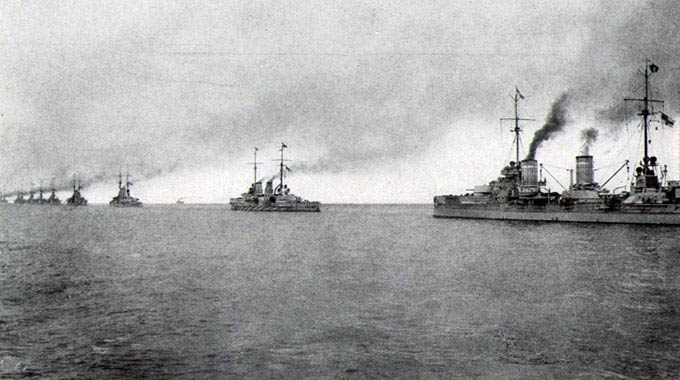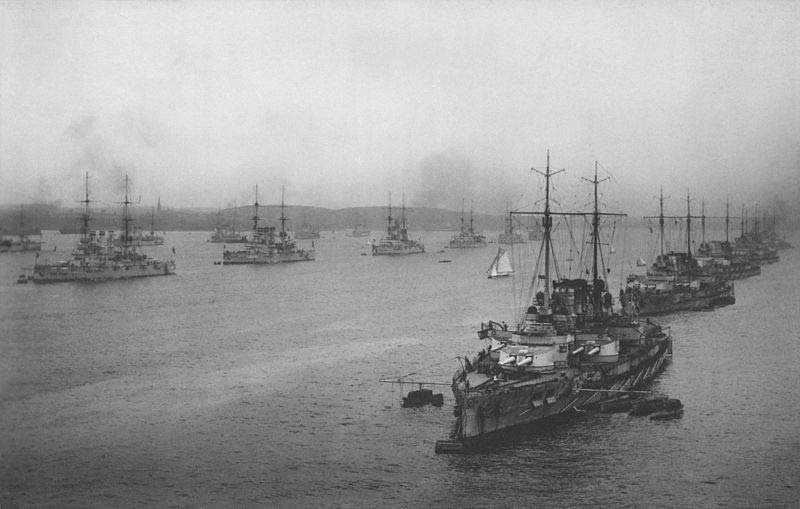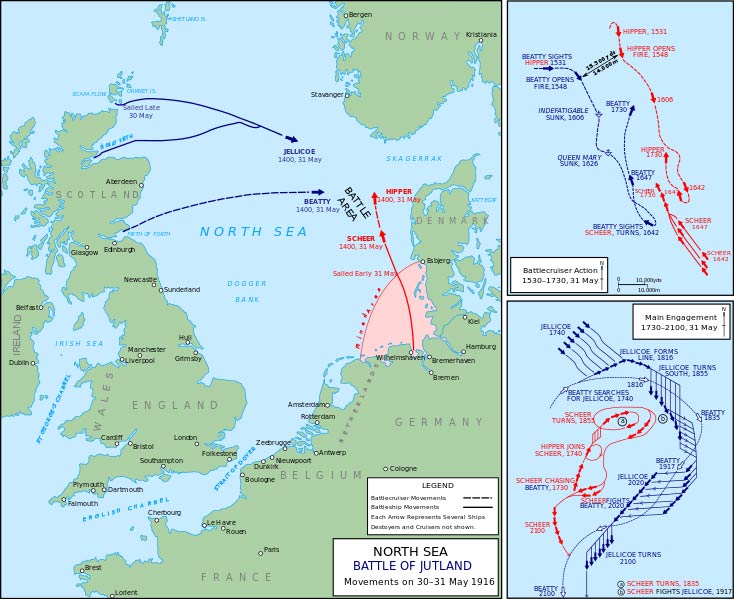 The High Seas Fleet was Germany’s Imperial Navy battle fleet which took part in the First World War. It was first created in February of 1907, when it replaced the Heimatflotte (Home Fleet). One of Germany’s top admirals, Alfred von Tirpitz, designed the fleet’s architecture. He wanted to develop a fleet that was so powerful that it could challenge Great Britain’s Royal Navy.
The High Seas Fleet was Germany’s Imperial Navy battle fleet which took part in the First World War. It was first created in February of 1907, when it replaced the Heimatflotte (Home Fleet). One of Germany’s top admirals, Alfred von Tirpitz, designed the fleet’s architecture. He wanted to develop a fleet that was so powerful that it could challenge Great Britain’s Royal Navy.
Tirpitz’s “Risk Theory”
Emperor Kaiser Wilhelm II supported this new fleet because he believed he could capture possessions overseas and that it would make Germany a worldwide power. Tirpitz thought that if Germany used this fleet primarily in the North Sea area, they could reduce the Royal Navy’s power because Britain had to disperse most of their fleet to many others areas in the British Empire.
Tirpitz’s main goal was to reduce Britain’s naval power. This concept was called Tirpitz’s “Risk Theory” and he really believed that the Royal Navy would not be a threat to Germany’s High Seas Fleet.
Germany’s Squadrons
The main element of the German Navy was its powerful battleships, which were generally structured in squadrons of eight ships. During its development, the High Seas Fleet was made up of just two battleship squadrons. But a new battleship squadron was added by 1914.
The Dreadnoughts
 In 1906, the dreadnought (type of battleship) revolution significantly affected Germany’s fleet. During this time, the fleet had nearly 25 pre-dreadnought ships. These ships were soon obsolete and had to be replaced. Germany only had enough of these dreadnoughts for only two complete squadrons when World War I broke out in 1914.
In 1906, the dreadnought (type of battleship) revolution significantly affected Germany’s fleet. During this time, the fleet had nearly 25 pre-dreadnought ships. These ships were soon obsolete and had to be replaced. Germany only had enough of these dreadnoughts for only two complete squadrons when World War I broke out in 1914.
Germany used eight of its most up-to-date pre-dreadnought ships to form a third squadron. Later, the German Navy was able to put together another two squadrons that were comprised of older ships. By the end of the First World War, these older squadrons were completely disbanded.
The Battle of Jutland
 The High Seas fleet executed a number of operations in the North Sea area during the war. These missions were meant to bring out the British Grand Fleet. The fleet often used their fast I Scouting Group battle cruisers along the British coast, hoping to attract the Royal Navy. These expeditions resulted in the famous Battle of Jutland, which took place from May 31, 1916, to June 1, 1916. Germany’s High Seas Fleet challenged the entire Grand Fleet.
The High Seas fleet executed a number of operations in the North Sea area during the war. These missions were meant to bring out the British Grand Fleet. The fleet often used their fast I Scouting Group battle cruisers along the British coast, hoping to attract the Royal Navy. These expeditions resulted in the famous Battle of Jutland, which took place from May 31, 1916, to June 1, 1916. Germany’s High Seas Fleet challenged the entire Grand Fleet.
Some historians believe the battle ended inconclusively, although others believe that Great Britain won. Germany’s Fleet Commander, Admiral Reinhard Scheer, believed that even if they won the battle, it did not mean that Germany would win the war. Scheer, as well as several other top admirals, encouraged the Kaiser to continue their unrestricted submarine or U-boats warfare campaign.
The End of WWI
From 1917 to 1918, the fleet’s main duty was to secure all of Germany’s North Sea Naval Bases for their U-boat missions. The naval fleet also conducted various operations in the North Sea area. They also sent ships to the Baltic Sea for special operations against Russia’s Baltic Fleet.
After Germany’s defeat in November of 1918, most of its fleet was moored in the Scapa Flow. In June of 1919, the fleet’s crew scuttled most of the ships, just days before the Treaty of Versailles was signed.